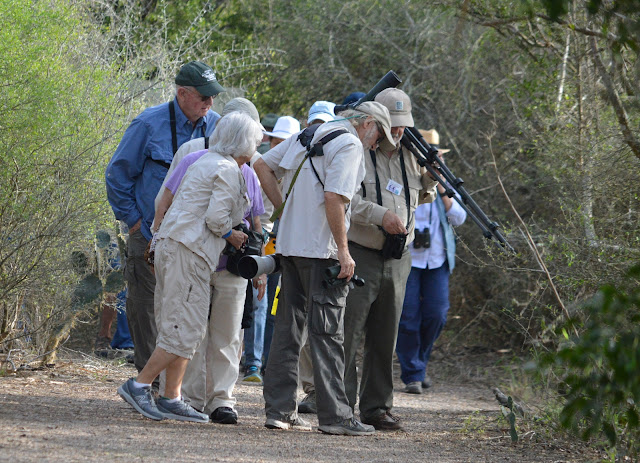The weather was beautiful this afternoon, a relief after the past few days pushing up to 100F. By early afternoon Lorna was going stir-crazy, "Let's go somewhere, I don't care, anywhere!" So we did.
After checking in legal-like at Estero Llano S.P., we decided to work our way through the thorny woods on the Green Jay Trail, hoping to get eyes on a Clay-colored Thrush or two. There were no birds to speak of, but we did find a Band-celled Sister (I cannot resist, "A close relative - Twisted Sister - also has a band".)
Emerging from the woods into the sunshine we wandered down a back lane to where our friend, park volunteer Rick Snider, has put up a few hummingbird feeders. By chance Rick was there with his camera set up near a feeder taking photos of visitors to the feeder. (The feeder is visible near the right edge of the following photo.)
We sat down on a bench in the shade across the road behind Rick, about 40 feet from the feeder - close enough to watch the action, maybe a little far for my lens, but close. A Black-chinned male hummer soon showed up and began feeding.
The Black-chinned are similar to the Ruby-throated we have back in Minnesota, which also winter here, so it is fun to sort them out. So often if the sun doesn't hit the ruby throat it shows up as black which makes it tough. The Black-chinned beaks are a little longer, the wingtips broader. Rick is a wonderful teacher and also mentioned that their backs are duller, darker, not as iridescent as the Ruby-throated. He also mentioned in passing that the female's beaks are slightly shorter. Some of this is not in the Sibley Field Guide. Rick has spent a lot of hours, of days, months, years studying Hummingbirds. From photos he can identify individual birds.
As we were watching the Black-chinned, a Buff-bellied Hummingbird approached. Hummed up? For photography purposes, Rick has taped all the holes except the one nearest the camera. The Black-chinned had possession and he was damned if he was going to give it up. He told the Buff-bellied in no uncertain terms to get lost. For a bird the size of a large bug they can chirp surprisingly loud.
The Buff-bellied was threatening, but it was all bluster. Our little boy gave no quarter and only gave up his feeding hole after his appetite had been sated.
Only then did the Buff-bellied get his turn at the sugar trough.
Beautiful weather. Its all fun and games - Gunnar



























































